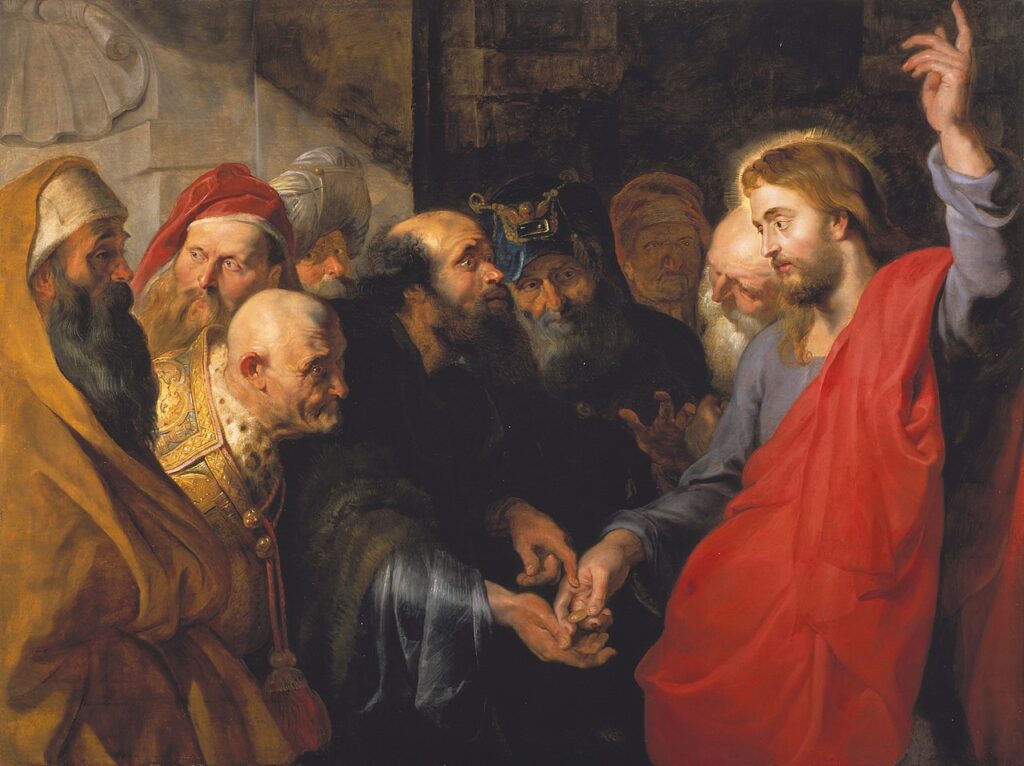Like Cantata 162, BWV 163 was also composed in Weimar, this one for the 23rd Sunday after Trinity. Its first performance was on November 24, 1715. We don’t know conclusively that Bach presented the cantata in Leipzig, since we don’t have surviving parts or any other document to prove it. Scholars believe that a 1723 performance is likely since we also don’t have documentation for any other cantata performed on that Sunday.
Similarities with 162 abound. Like its sister, 163 is a “solo” cantata, meaning that it doesn’t include any choral movements (except for the final chorale). Its orchestration is also similar and small, chamber-music scale: strings, continuo and 4 vocal soloists, although with the unique feature of requiring 2 solo cellos for the bass aria.
Its libretto is, too, by Salomo Franck, who draws on the Gospel for that Sunday, Matthew 22: 15-22. This passage narrates the story of the Pharisees trying to trick Jesus with a question about whether taxes should be paid to Caesar. The opening movement is based on Jesus’ often-quoted answer to this question (“Render to Caesar the things that are Caesar’s, and to God the things that are God’s”), and the bass recitative and aria that follow elaborates on the reference to the coin mentioned in the story and the image on it. A related and interesting fact about Franck: he was also the Court numismatist, in charge of Duke Wilhelm’s coin collection!
The work opens with a da-capo aria for the tenor, featuring a catchy, jumpy motif, introduced by the basso continuo, quickly echoed by the upper strings, and then picked up by the voice line. The wide leaps are also pervasive in the aria’s middle section. Do we hear jingling coins?
The bass is next with a recitative / aria set. The secco recitative becomes intense towards the end, as the text references “bad money”, “Satan”, and the “false coin”, which Bach illustrates with harsh dissonances. The aria is very unique in its orchestration, requiring two solo cellos. The four parts, all in the same range, produce a dark but flowing and animated texture. The pattern of constant 16th notes in wide intervals continues to be present in the cellos, as was the case in the tenor aria. The strong invocations (“Come, work, melt, and mold”) are set to melodic octaves on the voice and repeated three times, for striking effect, finishing off with a long, high note on “renewed”. This is, to my ears, cutting-edge musical language, especially considering that it comes from a young Bach!
The last two movements further the poet’s reflections but without showing strict adherence to the Gospel text. Movement 4 shows us additional experimentation by Bach, as he sets the text in the somewhat unusual form of a dual recitative for the soprano and alto. It starts with an alternation of imitation and homophonic sections between the voices, and eventually becomes an arioso with tempo markings – “un poc’ allegro”, then “adagio.” Word painting is used, such as long melismas on the word “voll” (“mit deiner Gnade voll”, “full of your grace”).
The recitative is followed by an aria, also set as a duet for the same two voices, with a chorale tune superimposed, given to the violins and violas in unison. The text of the aria is a prayer to Jesus to give himself to the believer (“give yourself to me with your kindness”), while the tune refers to a hymn thematically related: “Meinem Jesum laß ich nicht” (“I will not let go of my Jesus”), by Christian Keymann (1658).
The chorale that closes the cantata is by Johann Heermann, of 1630. The surviving score only has the basso continuo line for this movement, marked with the indication “Choral. Simplice stylo”. We know the melody that went with the text, so it’s straightforward to reconstruct the full chorale in four-part harmony.
